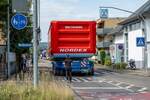News Release from windfair.net
Wind Industry Profile of
European Energy Transition: Light and Shadow
At the beginning of the new year, there is traditionally a brief look back. Most people probably want to forget 2020 as quickly as possible, but despite all the horrors that Corona/COVID-19 brought, there were also bright news like the advance of renewable energies that was unstoppable.
Of course, the pandemic has also played its part in this, because the shutdown of the economy has ensured a dramatic reduction in CO2 emissions in many places. As a result, e.g. Germany has managed to meet its 2020 climate targets - a goal that seemed a long way off at the beginning of the year. According to estimates by think tank Agora Energiewende, Germany reduced its greenhouse gas emissions by over 80 million tonnes of CO2 to around 722 million tonnes. However, two thirds of this reduction are corona effects, as Agora points out. Without the pandemic, the reduction would have been only about 25 million tonnes. "In 2020, real climate protection effects were only to be found in the electricity sector, because here the CO2 reduction is due to the replacement of coal with gas and renewable energies," Dr. Patrick Graichen, Director of Agora Energiewende, makes clear.
In the electricity mix, gas, coal and nuclear power plants lost 6 percent in 2020, supplying only 50 percent of Germany's electricity for the first time. Renewables, on the other hand, were able to increase their production to 45 percent, and excluding the electricity export surplus, renewables even reached a share of 46.2 percent, an increase of 3.8 percent compared to the previous year.

The Corona pandemic had a major impact on energy supply last year (Image: Pixabay).
However, these figures should be treated with caution, because "without Corona and the resulting 3.6 percent drop in electricity demand, the share of renewable energies in 2020 would have been only 44.6 percent," according to Agora. Two-thirds of the increase in renewables is due to a generally good wind year and increased production of offshore wind energy. Photovoltaics contributed one third.
At the same time, however, Patrick Graichen insists on the necessity of further efforts: "The growth in renewable energies with only 12 terawatt hours is clearly below the average of the last years due to the crisis in wind power. This isn't nearly enough for Germany to reach its climate targets for 2030. To do so, the expansion of wind power must be tripled and that of solar doubled. This corresponds to the installation rates we already had a few years ago. Germany has managed to increase the share of renewables in electricity consumption from 17 to 46 percent over the past ten years. We now need a similar effort consistently until 2030."
Meanwhile, positive figures are also coming from other European countries: In 2020, renewable technologies produced 43.6 per cent of all electricity in Spain. It is the largest share of the generation mix since records began in 2007, reported Red Eléctrica de España (REE), Spain's transmission system operator. This represents a 6.1 per cent increase in renewables compared to 2019 and is 3.2 per cent higher than the previous annual peak in 2014.
In Denmark, too, renewables took over a large part of the electricity supply. Whether it was enough to beat its own record of 47.1 per cent from 2019, however, is not yet entirely clear, as Energinet, the Danish transmission system operator, explained. Initial evaluations indicate that the share may even have been 50.4 per cent in 2020.

Hydrogen as a source of hope (Image: Pixabay)
And another problem came to light: the Danish wind farms had to be shut down more often than ever before. The reason: there was no buyer for the electricity produced. Neighbouring Germany couldn't pass on the green electricity from Denmark and northern Germany to consumers in southern Germany as the high-voltage grid was overloaded. So the Germans paid the Danes to switch off their wind turbines, because the electricity couldn't be taken off in Denmark itself either.
This problem could be reduced in the near future, however, if hydrogen technology, which is currently hyped everywhere, picks up speed. Then it would be possible to convert wind power into hydrogen in times of overproduction to store it until it's needed again. Pushing ahead with the energy transition in the transport and heating sectors will also help to reduce the standstill so that further records can be broken in the future.
- Author:
- Katrin Radtke
- Email:
- press@windfair.net
- Keywords:
- Germany, Denmark, Spain, energy transition, Europe, transmission grid, electricity, production, renewable energy, mix, corona, COVID-19

























